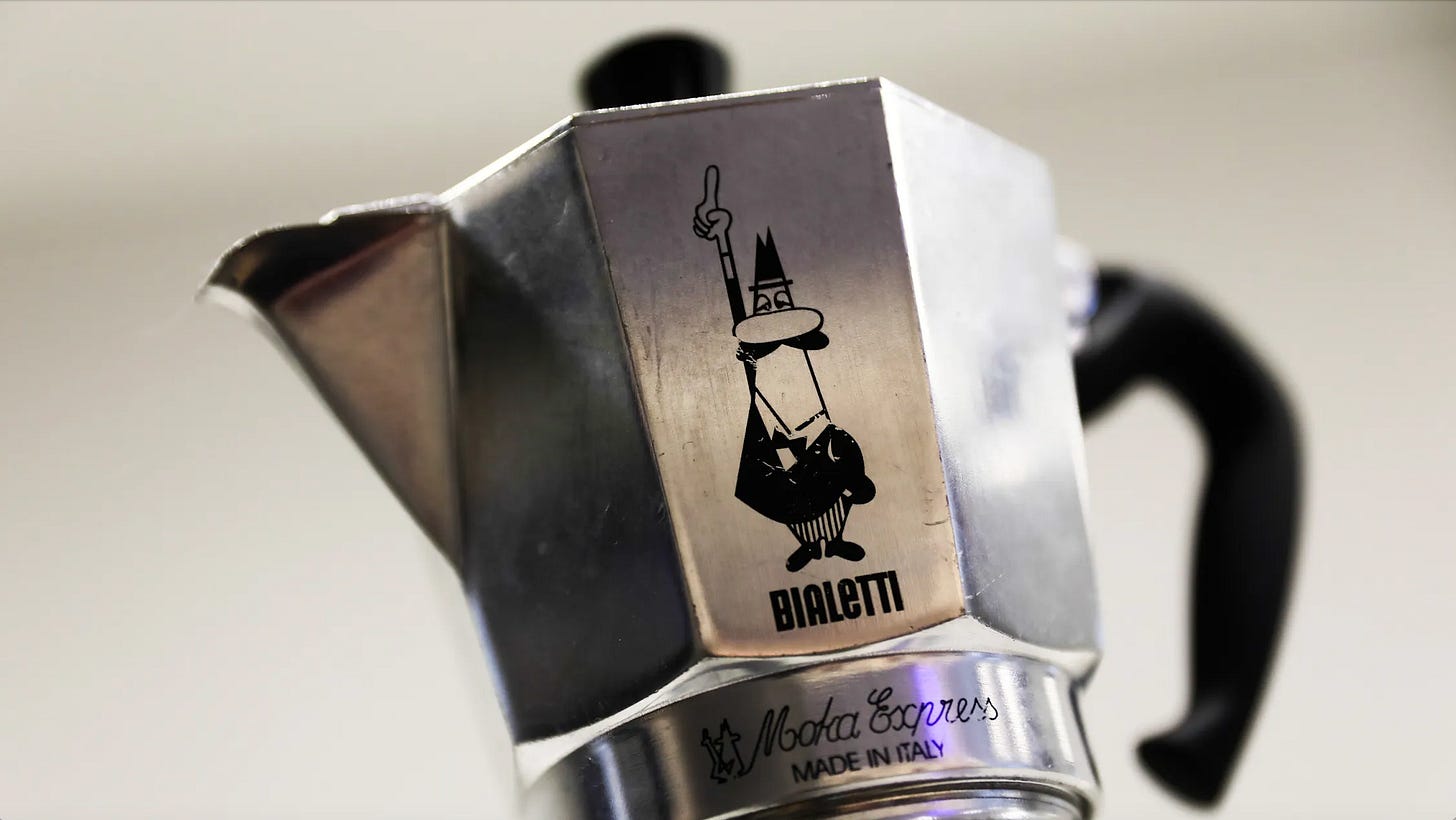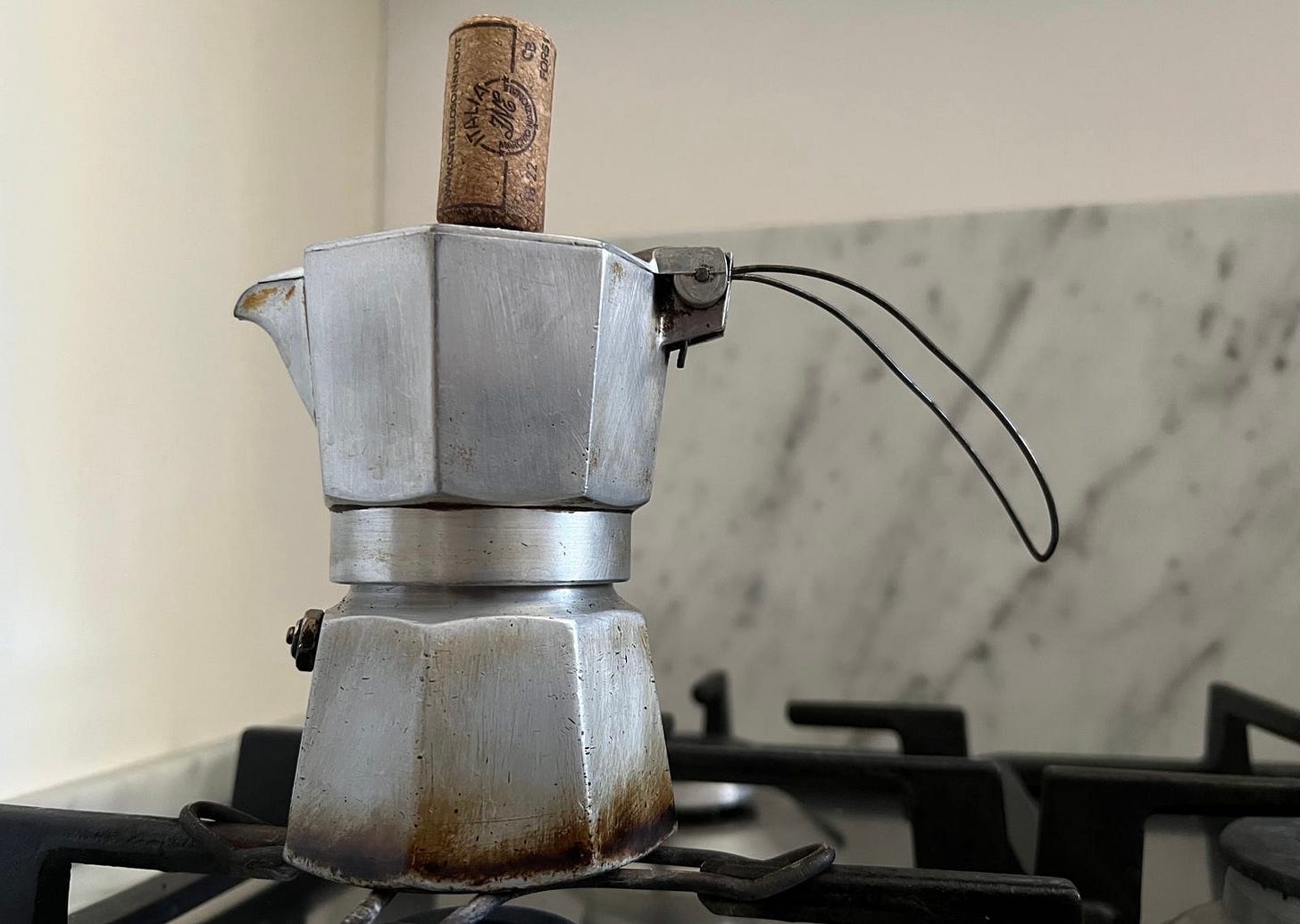Is ‘Made in Italy’ Still Italian?
What the humble Moka pot tells us about the fate of Italy’s icons
A few weeks ago, Italian media focused -- briefly but intensely -- on news that a Hong Kong holding company had agreed to acquire Bialetti, maker of the beloved Italian Moka coffee pot.
“Bialetti becomes Chinese,” declared Il Foglio. Il Fatto Quotidiano sighed, “Another symbol of ‘Made in Italy’ is leaving.” And La Repubblica lamented, “Have a good trip, Bialetti; now the man with the moustache will make coffee for the Chinese.”
Aluminum worker and inventor Alfonso Bialetti invented the Moka Express pot in 1933. Since then, the company has sold more than 300 million of them. Around three in four Italian households have a Moka pot in the kitchen. Its eight-sided, art deco silhouette -- practical, unmistakably Italian -- is so ingrained in the culture that it appears in the permanent collection of New York’s Museum of Modern Art, the Triennale Design Museum in Milan, and other design collections.
The modest aluminum Moka pot ranks among Italy’s most recognizable design icons, along with the Vespa scooter, the Fiat 500, Alessi homeware, Panerai watches, and Ferrari.
But ask Moka pot devotees why they still use a device that’s remained almost unchanged for nearly a century and one word comes up over and over: “ritual.” Using one is a sensory experience: the dry rasp of aluminum on aluminum as the top and bottom chambers screw together, the gurgling of the coffee as it bubbles up through the grinds, and the rich aroma that fills the air when the coffee is ready.
And now the Moka is going to be Chinese? Really?
Exporting a national identity
One by one, the symbols of post-World War II ingenuity are becoming assets in global investment portfolios. Jewelry maker Bulgari is now owned by France’s LVMH, Switzerland’s Nestlé controls sparkling water maker San Pellegrino, and British holding company Iconic has a big stake in design company Alessi. Even Fiat has been folded into Stellantis, a multinational conglomerate that, somehow, is simultaneously based in Amsterdam, Detroit, Turin, and Paris. Many of Italy’s best-known fashion houses are now part of international groups.
And the acquisition of Bialetti is not China’s first foray into the Italian arena: tire maker Pirelli, appliance manufacturers Candy and De’Longhi, and luxury yacht brand Ferretti are all controlled by Chinese companies.
I spoke about the trend with Elena Dallapiana, a professor of design and contemporary architecture at the Polytechnic University in Turin. She said the case involving Bialetti has attracted more attention than some other deals because it’s a product used every day in millions of Italian homes and the acquiring company is from China, a country with a culture that differs so dramatically from Italy.
“We Italians can be nationalistic,” Dallapiana said. “There’s an instinctive discomfort with the idea that a product so central to our hearts will answer to a hierarchy based in China.”
I pushed a little harder: “What about if the acquiring company was French?”
“No, no, that would be nearly as bad,” she said. “The French are like cousins and cousins can be annoying.”
“An American company?”
“There was a time when that wouldn’t have been much of an issue, but now, I think the American image is tarnished now because of the politics, the tariffs, and the rest,” Dallapiana said. “So, no, it wouldn’t be much better if it had been the Americans.”
“What is a country that, if it had acquired Bialetti, would be seen as OK?”
Dallapiana paused for a few seconds. “I don’t think any country would be completely acceptable,” she finally said.
Almost indestructible
Artisanal production has deep roots in Italy, dating back to Medieval guilds and Renaissance workshops, fueled by Italy’s role in the middle of the Mediterranean Sea, making it a crossroads of cultures and products.
According to brand strategy and experiential marketing commentator Carlo Fei, a business professor at Rome’s LUISS University, that storied history is also marked by repeated foreign interventions, influencing areas now considered uniquely Italian.
Some examples: Spain’s introduction of tomatoes, potatoes, and cacao to Italy (all from the New World); coffee coming to Venice via the Ottoman Turks; manufacturing in the north impacted by German-speaking countries; France’s ties to Italian fashion and luxury goods; or the U.S. influence on Italian film and finance. Now, Chinese companies are increasingly involved.
“The question is, how can Chinese ownership help a company like Bialetti?” Fei asked. “Well, one thing is to improve the company’s financials and to have a long-term vision, because a company that’s only looking at the next financial quarter will struggle.”
Bialetti’s been struggling for years, saddled with debt. The company is a victim of the rising popularity of electronic coffee pod-based machines, and a virtually indestructible design that eschews the notion of “planned obsolescence” that results in us replacing our mobile phones and appliances every few years. Instead, Moka pots are handed down from generation to generation.
Four years ago, I wrote a long feature in Fortune Magazine focused on how Bialetti’s prospects were improving as the coronavirus pandemic sparked a revival of coffee making at home. For the first time in years, sales were on the rise, the company was slowly paying down its debt, and it began working on plans to branch out into other coffee-related sectors. But as life returned to normal after the pandemic, the previous problems resurfaced. The company had reportedly been shopping itself around since 2023.
Fei said the key to a new turnaround for Bialetti will require its new owners to find ways to revitalize the Moka pot and introduce it to a new generation of consumers. Taking care of the company’s debt load -- reported to approach €100 million -- and strategically leveraging its history and design are key.
The press office for Nuo Capital, the holding company acquiring Bialetti, wouldn’t provide many details about its strategic plan for Bialetti when I contacted them. A spokesman would only say that it intends to protect the qualities that made the Moka so loved by so many people.
“We’re not talking about a clever new ad campaign,” Fei said. “The whole supply chain must be reimagined and then rebuilt, but without distorting the nature of the brand. It must be done carefully. But I can imagine the Moka coffee pot becoming cool in a retro way.”
Post-scriptum:
When Italians ask me my dog’s name, the most memorable way I’ve come up with to explain it is: “It’s ‘MOW-kah’ … like the coffee maker.” It seems to work, since more people know her name around the neighborhood than they do mine.
(The official spelling of her name is “Mocha” and everyone thinks she’s cute and sweet; you can find out more about her here).
I can divide my life into five coffee-related chapters: there was the instant coffee stage back in college, then the Mr. Coffee phase before moving abroad. For a long time, I used a French press, before graduating to the pour-over method. But now I’ve happily settled on the Moka pot.
I’ve come to love my Moka pots (I have three different sizes) for the same reasons Italian do -- the tradition and the I like the sensory ritual I described above, along with the satisfaction of making something by hand rather than just pressing a button or flipping a switch. I also appreciate that it’s environmentally sustainable -- the only waste is the compostable coffee grinds. No filters of pods to dispose of.
But it’s the taste that keeps me coming back: the aromatic coffee the Moka pot produces is rich and robust without being overpowering. And no barista-level skills are required.
When I was working on the Fortune Magazine article mentioned above, I interviewed a Bialetti “coffee quality engineer,” who told me his best advice for new converts to the Moka pot system was:
• Fill the bottom chamber only to the safety valve
• Level out the grinds by tapping the filter basket, not tamping down the grains themselves
• Keep the top closed until the coffee is ready
• Turn off the heat when the gurgling becomes loud and then waiting until it’s silent before serving.
Come back for another dispatch next week.







Touché on a fun read. I keep two Bialettis in Rome and two in the States, different sizes. You never know who's coming to dinner and who might want un caffe to top off a meal. That metal crunch on metal when screwing it together indeed is satisfying. There was a housewares store near Piazza Venezia that had a whole room full of Bialettis in a rainbow of colors. Store closed. Should have stocked up on some collector items.
I had 4 Bialettis in Nairobi to accommodate large dinner parties. I would stop in Rome during my homeleave to the States to go Standa to buy the spare parts. I still have 2 Bialettis in New York